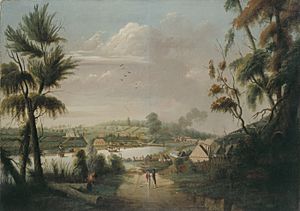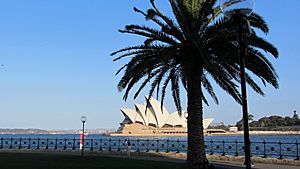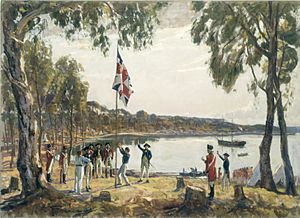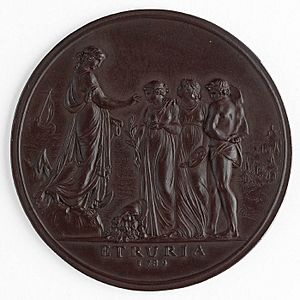Sydney Cove facts for kids
Sydney Cove is a small harbour in Sydney, New South Wales, Australia. It is a very important place in Australian history. This is because the first Europeans to arrive in Australia landed here on January 26, 1788.
Contents
History of Sydney Cove
The Aboriginal people had their own name for Sydney Cove. They called it Warrane. Other spellings like War-ran, Warrang, and Wee-rong were also used. This area was very important to the Eora people, who were the local Aboriginal group. It was also the first place where the Eora people met the Europeans. The Eora people called the Europeans "Berewalgal," meaning "people from a distant place."
Warrane was a central part of the Eora people's daily lives. Men would fish with spears from the shore. Women used nowies (canoes) to fish with lines.
Naming Sydney Cove
Sydney Cove was named after a British government official. His name was Thomas Townshend. He was the first Baron Sydney and later became the first Viscount Sydney.
Captain Arthur Phillip of the Royal Navy chose this spot. He picked it between January 21 and 23, 1788. This was to be the site for a new British settlement. This settlement later grew into the city of Sydney. On January 26, 1788, the British officially claimed New South Wales here. This day is now celebrated as Australia Day. Today, the exact spot where the flag was raised is under buildings near Circular Quay.
Why Sydney Cove Was Chosen
Captain Phillip was first told to set up the settlement at Botany Bay. This large bay was south of Sydney Cove. Lieutenant James Cook had found it in 1770. Sir Joseph Banks, a famous botanist who traveled with Cook, also thought Botany Bay was a good spot.
However, Phillip found that Botany Bay was not suitable. It did not have a safe place for ships to anchor. It also did not have a reliable source of fresh water. Sydney Cove had both of these important things. It had a freshwater creek, which became known as the Tank Stream.
It must have felt like entering a wonderful place. The ships sailed through the rocky headlands into the untouched harbour. The water was bright blue. The shores were high and covered with trees. There were also some islands and sandy beaches. The trees seemed to shine in the sun.
Sydney Cove was chosen because it had fresh water. It also had a good place for ships to anchor close to the land. The Governor's team cleared a camping area next to the creek. This creek flowed quietly through a very thick forest. The sounds of workers' axes were heard there for the first time.
Today, the Tank Stream flows through a concrete drain. It is hidden beneath the streets of the city center. All the original bushland has been cleared away. The main part of the cove is now the Circular Quay ferry terminal. The Sydney Opera House stands on Bennelong Point. This is at the northern end of the eastern shore. On the western shore is a historic area called The Rocks.
Sydney Cove Medallion
Governor Phillip collected a sample of dark grey clay from Sydney Cove. He gave it to Sir Joseph Banks. Banks then gave it to Josiah Wedgwood, a famous pottery maker. Wedgwood tested the clay and found it was excellent for making pottery. He then made a special medal to remember the event. This medal is known as the Sydney Cove Medallion.
Images for kids
See also
 In Spanish: Cala de Sídney para niños
In Spanish: Cala de Sídney para niños







